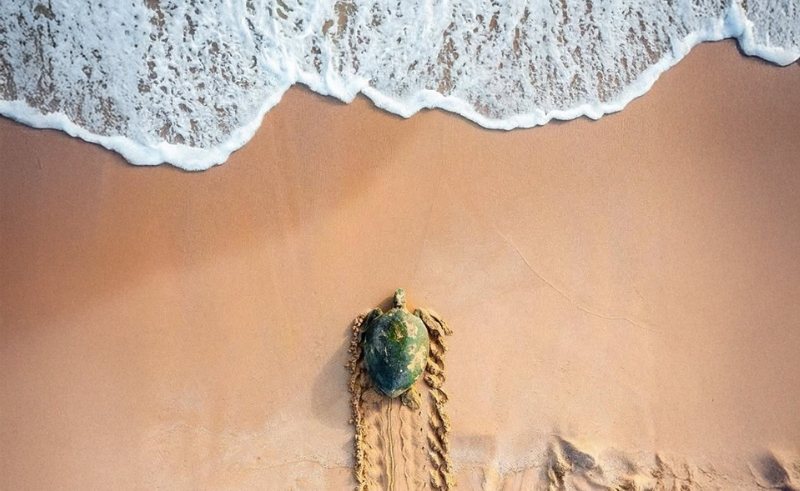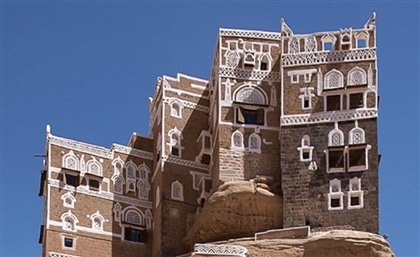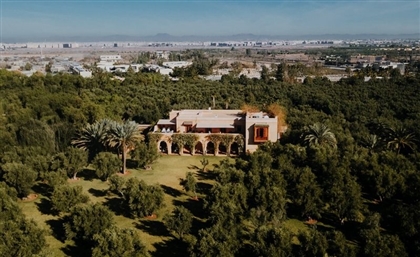This Secret Omani Coast Is Where Turtles Hatch Before Your Eyes
At the edge of Oman’s coast, Ras Al Jinz is where desert and Red Sea meet, and where thousands of green turtles return each year to nest beneath the stars.

At the far end of Oman’s coast, where the desert finally runs out of patience and spills into the sea, lies Ras Al Jinz. The road east from Muscat drifts through open plains and quiet fishing towns before ending at a small cluster of dunes and a narrow crescent of beach. It feels like the edge of the map; he kind of place you find only by following the road long enough.
-fb1d720e-63f7-415c-8199-2a6aaebebcc5.jpg) This is where thousands of green sea turtles come ashore each year to nest. By day, the coast seems almost uneventful: pale cliffs, soft sand, a few gulls cutting across the wind. But once the sun drops, the beach transforms. Somewhere in the dark, a shadow starts to move: a turtle, heaving herself from the surf. She pauses, breathes, and begins to dig. The sound of her flippers scraping sand fills the silence. When she’s done laying her eggs, she buries the nest, erases her tracks, and disappears back into the waves. The beach is still again, as if nothing had happened.
This is where thousands of green sea turtles come ashore each year to nest. By day, the coast seems almost uneventful: pale cliffs, soft sand, a few gulls cutting across the wind. But once the sun drops, the beach transforms. Somewhere in the dark, a shadow starts to move: a turtle, heaving herself from the surf. She pauses, breathes, and begins to dig. The sound of her flippers scraping sand fills the silence. When she’s done laying her eggs, she buries the nest, erases her tracks, and disappears back into the waves. The beach is still again, as if nothing had happened.
-0be9e558-bfd7-4b69-aa84-f365d2ce4be9.jpg) Nesting peaks between June and September, though turtles arrive year-round. A couple of months later, the hatchlings break through. Small. Frantic. Determined. They scatter toward the sea, pulled by instinct and moonlight. Watching them go, you can’t help but think about how few will make it back.
Nesting peaks between June and September, though turtles arrive year-round. A couple of months later, the hatchlings break through. Small. Frantic. Determined. They scatter toward the sea, pulled by instinct and moonlight. Watching them go, you can’t help but think about how few will make it back.
-1cdfc532-5522-470f-8068-1cf9ecef2377.jpg) Most travellers stay at the eco-lodge tucked behind the dunes: a low, sand-coloured complex of rooms and canvas tents that blend into the landscape. There’s a small museum, a café, and a viewing deck facing the sea. It’s simple, quiet, and exactly what this place needs to be. The rangers who lead the night walks are calm but firm about the rules: no flash, no shouting, no chasing. It takes only a few minutes on the beach to understand why. Light and sound can throw off entire nesting cycles. Balancing conservation with curiosity is delicate work, and they treat it like a calling.
Most travellers stay at the eco-lodge tucked behind the dunes: a low, sand-coloured complex of rooms and canvas tents that blend into the landscape. There’s a small museum, a café, and a viewing deck facing the sea. It’s simple, quiet, and exactly what this place needs to be. The rangers who lead the night walks are calm but firm about the rules: no flash, no shouting, no chasing. It takes only a few minutes on the beach to understand why. Light and sound can throw off entire nesting cycles. Balancing conservation with curiosity is delicate work, and they treat it like a calling.
-632356da-5762-4cf3-91da-2fb2f04c0c6f.jpg) The reserve itself stretches across more than a hundred square kilometres of coastline, lagoons, and seabed. Archaeological finds—shards of pottery, fragments of tools—link this coast to ancient trade routes that once connected Oman with the Indus Valley. The same waters that carry turtles today once carried ships heavy with copper and frankincense, connecting past and present in a quiet, almost invisible line.
The reserve itself stretches across more than a hundred square kilometres of coastline, lagoons, and seabed. Archaeological finds—shards of pottery, fragments of tools—link this coast to ancient trade routes that once connected Oman with the Indus Valley. The same waters that carry turtles today once carried ships heavy with copper and frankincense, connecting past and present in a quiet, almost invisible line.
-69f323f2-dca9-412f-a4cb-e79bd6098db4.jpg) Mornings here are worth staying for. When the tide pulls back, it leaves faint tracks where turtles moved under the stars. The cliffs catch the first light, and fishing boats hum toward the horizon. It feels like the world waking up for the first time.
Mornings here are worth staying for. When the tide pulls back, it leaves faint tracks where turtles moved under the stars. The cliffs catch the first light, and fishing boats hum toward the horizon. It feels like the world waking up for the first time.
-d45973f1-1794-4c87-8c86-aa9556088163.jpg) Ras Al Jinz isn’t about luxury or lists. It’s about witnessing something ancient that still happens, quietly, on its own terms. You drive east for hours, and the road ends not in spectacle, but in a dark sky and the soft hum of waves—where, every night, life begins again.
Ras Al Jinz isn’t about luxury or lists. It’s about witnessing something ancient that still happens, quietly, on its own terms. You drive east for hours, and the road ends not in spectacle, but in a dark sky and the soft hum of waves—where, every night, life begins again.
Trending This Month
-
Nov 29, 2025























